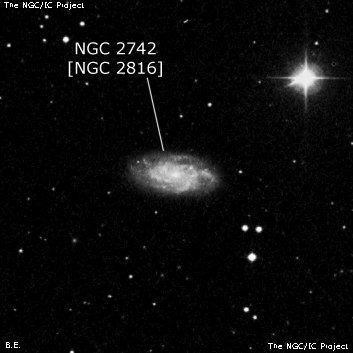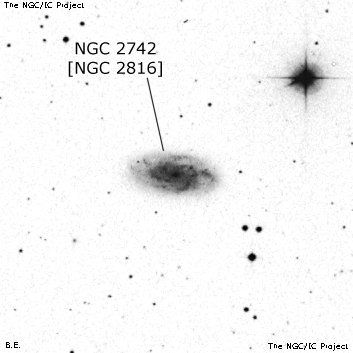NGC/IC Project Restoration Effort
(This is a very very beta version)
NGC2816


Basic Information
Location and Magnitude
Right Ascension: 9:21:46.0
Declination: +64:15:31
Constellation: UMA
Visual Magnitude: 12.8
Historic Information
Discoverer: Herschel J.
Year of discovery: 1832
Discovery aperture: 18.3
Observational
Summary description: F, pmE
Sub-type: SBc/P
Corwin's Notes
=====
NGC 2816. Years ago, I wrote this about NGC 2816:
[This] is probably JH's second observation of NGC 2742. The first came on
8 March 1832 where the galaxy is recorded at its correct position, close to
where his father placed it when he found it in 1790. JH called it "vF, pL,
R, vgbM, 60 arcsec; moon very troublesome. A * 8 m np." (This compares to
his father's rather more interesting note, "cB, E near par., er, bM; 4' l,
2' b. I suppose, with a higher power and longer attention, the stars would
become visible." WH's "er" means "extremely mottled," which leads to his
comment about the stars.)
Just three weeks later, on 30 March 1832, JH swept over the area again, this
time recording a "F, pmE" nebula 13m 30s to the east at the same north polar
distance. There is nothing at that position, a fact first noticed by
Reinmuth in his 1926 "Die Herschel Nebel."
Since the declination is the same, and the description for N2816 appropriate
for N2742, I'm going to suggest that the two nebulae are the same. Even
though the RA difference is large, there is nothing else around that JH
might have seen that makes more sense to me. Still, I'm not convinced, so
I've put colons on the identification.
(At least I had the sense to mark the identity uncertain.)
In fact, NGC 2816 is simply non-existent. The observation that led to it is
indeed one by JH on 30 March 1832, but, as Wolfgang pointed out in March 2014,
that was actually of NGC 2820. In that same sweep, JH picked up, just 45
seconds earlier, another galaxy that he believed to be H II 869 and became
h 576. His second object, h 579, eventually led to the numbers GC 1800 and
NGC 2816.
But the north polar distance for this second object is clearly mis-reduced.
In the log book for the sweep, preserved in the Herschel Archive, we find that
the raw observations for the NPDs, referred to a zero point within the sweep,
read 01 53 18 for h 576, and 01 54 30 for h 579. Yet the reduced north polar
distances for 1830 read 25 02 45 for h 576, and 28 50 33 for h 579, over 3 3/4
degrees apart. (These are the numbers that also appear in JH's 1833
monograph. Only two other objects appear in the sweep, the stars HD 80953 and
81161; their positions are correctly reduced as is that for h 576 = NGC 2814).
Using the difference between the raw and reduced NPDs for h 576 = NGC 2814 as
a guide, the correct reduction of JH's NPD for h 579 becomes 25 01 33. His
position is therefore a good match for NGC 2820, and there is no doubt that
NGC 2816 is identical to this large, faint, edgewise spiral galaxy.
So, the NGC needs fixing: Add the number h 576 to NGC 2814, note GC 1800 =
NGC 2816 as being identical with GC 1798 = NGC 2820, and change the JH number
"576" on NGC 2820 to "579". The NGC positions for the two galaxies are about
10 seconds of time too far east, but are otherwise OK, so there is no doubt
about the identifications.
By the way, the faint companion to NGC 2820, Markarian 108, is not IC 2458
(which see) as I and many others had suggested. The IC object is actually the
northeastern part of NGC 2820 itself. I've retained the alternate designation
for Markarian 108, however, so you will find it listed as "NGC 2820A" in the
big position tables.
Steve's Notes
=====
NGC 2816
See observing notes for NGC 2820.



